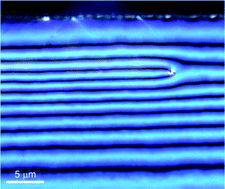
Example of nematic texture and defect structures observed in liquid crystals confined in micro-channels.
Can the flow of active and passive liquid crystals be accurately described using the same theoretical model? This was the question posed by Miha Ravnik, from the University of Oxford in a recent seminar. The motivation for this work is to improve the understanding of liquid crystal (LC) flow in micro-channels. The coupling of material flow with orientation in LC, via internal material stress, is very interesting both technologically, as a driving mechanism for controlling material flow, and for understanding the behaviour of artificial and biological swimmers. Flow is also important for understanding topological defects in LC (Soft Matter doi: 10.1039/B810933H).
The model of Ravnik is based on the phenomenological Beris-Edwards model, solved using a hybrid lattice-Boltzmann method. The equations couple the orientation, described by an order parameter, with the flow velocity field, which is modelled using a generalised Navier-Stokes description. The orientation describes the LC alignment in the flow, the molecular field and the internal motility of the LC (this is zero for passive LC). The results show that for both passive and active LC the behaviour is dependent on the magnitude of the driving flow and the dimensions of the channel. This includes the LC orientation and flow profiles and the position of defect lines.
Similar behaviour was recently observed experimentally by Sengupta et al. (Soft Matter doi: 10.1039/C1SM05052D), who studied the flow of nematic LC through micro-channels. Different textures and defect structures were observed to develop depending on the channel dimensions and the flow rate applied. Some very nice movies, showing the formation of these structures, can be found as supplementary information with the article.
Miha Ravnik is also interested in understanding the behaviour of topological defect loops seen when colloidal particles are added to liquid crystals (Soft Matter doi: 10.1039/B913065A). The controlled manipulation of these defect loops was discussed in a previous post.
A talk given by Ravnik on liquid crystal colloids can be found here. The talk presents routes for the functionalisation of colloidal particles and continuum liquid crystals.










